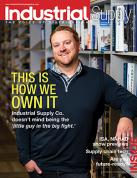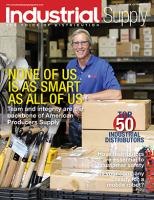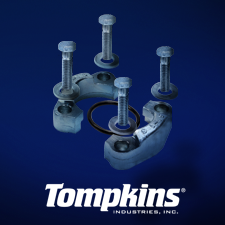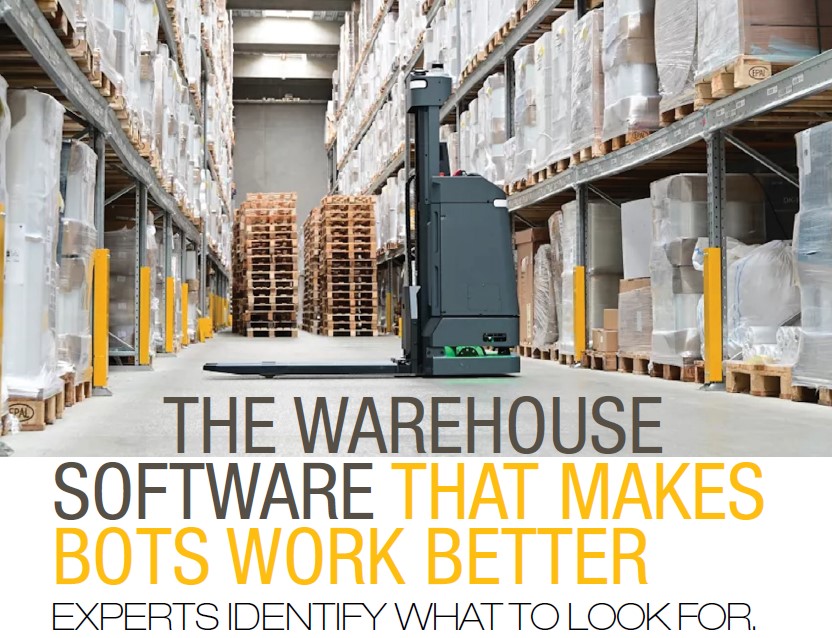 |
by Kim Phelan
Robots are more than just the talk of industrial distribution today – even the wait-and-see folks are investigating and investing in warehouse robotics. According to the International Federation of Robotics, the global market value of industrial robot installations has reached an all-time high of $16.5 billion this year. As industrial distributors increase their bot adoption, they’re expecting more from their warehouse management systems (WMS) and warehouse execution systems (WES).
While AMR and AGV brands bring their own value propositions, the real differentiator in this level of DC/warehouse automation is the software. Knowing the difference between WMS and WES is a good place to start. First, you can run a WMS with a WES, but a WES cannot run without a WMS, according to Kevin Graebel, chief marketing officer for Honeywell’s Intelligrated business who is also responsible for mapping corporate strategy for the division’s product development process. Honeywell recently released its Momentum WES as a cloud-based service as a software (SaaS). The company also announced its new partnership with robot maker Teradyne.
 |
| Graebel |
“The warehouse management system sits above the warehouse and helps a distribution company know where they have inventory in their network, and it helps them do things like order management and looking at transportation across their locations,” he said. “A WMS can directly fulfill an order. Even for simple automation solutions, the WMS can make a call directly to a stand-alone automation solution saying, ‘Hey, I need you to go pick this up and ship it out.
“Once you get above a certain complexity, or even a throughput in a system the WES is really going to help you get better outcomes from the equipment that you have. It streamlines the way that disparate systems operate together . . . and it’s much more dynamic in that it can adapt to challenges that might happen, such as lines being down, availability of resources, or different priorities of the different systems.”
Graebel added that Honeywell studies show that a WES can improve efficiency in the warehouse by 20% to 30%.
WHAT WAREHOUSES DEMAND
As interest in the integration of WMS and WES with robotics grows, customers including distributors want these systems to be implemented more quickly, according to Ryan Kirklewski, director of software product management at Dematic. Speed is a high priority and customers have little or no appetite for implementations that take years instead of months.
“They’re also looking for more flexibility in their system,” he said. “How you design and implement your system today is probably different than how you’ll need it to operate even a few months from now. Whether that is because you’re bringing in robotics, or you’re bringing in a new line of business, or you’re opening a new building, or shipping new types of product, you need to adapt that system to meet that new need. Adaptability is really important.”
 |
| Kirklewski |
WMS and WES software must also be bot agnostic, able to integrate with any OEM brand. But they also need to play well with other systems a distributor already has, such as the ERP. And even though WES is going to be better suited to multi-site distributors requiring more layers of complexity, demand for lower cost is something software providers have to respond to.
“I think the biggest trend is in accessibility,” said Graebel. “Five or six years ago, it would have cost you a couple million dollars. You’d need to have a very big operation to see a reasonable payback period on such a complex software installation.
“But what we’re seeing now is fewer new warehouses are being built, and so people are looking for ways to add value to their existing sites. Far more customers want to add robotics or add improved functionality to the investments that they’ve already made – sweat your assets.”
He asserts that WMS/WES products are becoming more accessible price-wise to a great swath of warehouse owners, and these buyers are looking for plug-and-play applications with drastically shorter installation timelines.
BRAINS AND BRAWN: DEMATIC’S VALUE PROPOSITION
Dematic says it specializes in harnessing WMS and robotics to powering smarter warehousing, and couples its software with both its own proprietary robots as well as other brands. From orchestrating order fulfillment to automating repetitive tasks, the company says these systems are helping facilities respond faster – with fewer manual touches and greater confidence.
Dematic is helping operations: Coordinate workflows, labor, and automation with integrated WMS, WES, and WCS platforms; deploy robotics for picking, palletizing, transport, and replenishment; improve accuracy and safety while scaling for peak demand; and helping distributors gain real-time insight into inventory, order status, and equipment utilization.
“Our objective with our customers is to be able to provide a more holistic optimization of their entire operation,” said Kirklewski. “When we’re talking about automation and robotics, we’re typically talking about things like order fulfillment, but that could be other tasks as well, such as transport tasks, replenishments, or other inventory type activities. It’s the responsibility of the WMS/WES to drive optimization through priority and timing of the tasking, as well allocating assignments of the tasking. The software is figuring out what tasks should be done at what time, by which person or machine, and to make sure that at the end of the day all the orders are going out on time as accurately, as efficiently, and as constantly as possible.”
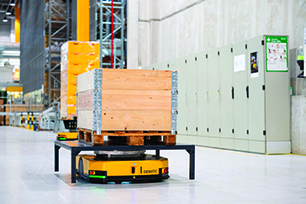 |
MORE THAN A BUZZWORD
AI is factoring large in the ongoing development of the software-robot integration at Dematic. Although AI now feels “buzzwordy,” says Kirklewski, he adds that the warehouse is 100% ripe with opportunity for automating myriad repetitive tasks as well as elemental decision-making.
AI computer vision will help ensure picking accuracy both in the right item and the right quantity. It may also be able to solve bottlenecks on a conveyor, for example, or an issue with a forklift in an aisle – and identify why problems occurred.
AI optimization will assist with demand forecasting, capacity planning, and supplier predictability, Kirklewski continued. “It will predict your potential demand for a certain item and make sure that you’ve not only got the right amount of product for that demand at the right time, but that it’s in a position in the warehouse that’s going to make the picking most efficient.
“We’ll start to use all this data for making decisions about how you are most efficiently going to fulfill an order,” he said. “You can start to make some intelligent predictions about when customers are going to want certain products. You’re just making your fulfillment operation that much more intelligent. So that’s the optimization AI.”
The third piece Dematic is focusing on is generative AI. “Making heads and tails of warehouse data has often been very difficult in these systems, because you have to know what report to run or have the right kind of dashboard, or know which screens to go to – and then how to interpret the data that you’re looking at,” said Kirklewski. “Digital AI assistants would give you the ability to interact with that data in a way that is easier to consume, easier to understand, and easier to react to.”
In the future, he says adding voice capabilities into the software-robot interface will become an important priority. Together with robot visibility technology, he envisions a future where ultimately warehouse employees can interact with these products as though they are another team member.
 |
GAINING ‘MOMENTUM’
The new collaboration between Honeywell and Teradyne Robotics is marrying Honeywell’s Momentum WES with Teradyne’s robotic technologies, but the software is also designed to be compatible with all other brands. The company says the combined strengths “will help companies tackle the challenges they are experiencing today with labor-intensive, inefficient material-handling tasks.”
Momentum WES has safety advantages. First, because of efficiencies realized from the software, workers won’t be called upon to work longer hours and will therefore be less fatigued on the job, according to Graebel.
“I think another element is just making sure that the right tasking is assigned to the right person at the right time,” he said. “If you have a robotic system that is operating in an aisle or location where there’s not supposed to be people working, the WES can just make sure that the people are where they’re supposed to be, and not moving them in those wrong locations.”
Going with a cloud-based SaaS can lead to cybersecurity benefits for distributors, too, according to Graebel. For example, when companies have taken core software and rewritten code to suit their unique needs, and then that team member leaves the company, it becomes very difficult to maintain the latest cybersecurity expectations for this older code, he said.
“If there’s a vulnerability that crops up in a third-party library, then you’re responsible for going into your code and finding all of the different pieces that might have been exposed to some of these vulnerabilities,” Graebel noted. “A much better best practice is to have a software package that is maintained by a vendor that’s continuing to invest in that platform, and patching can be done on that software package to address it for all of their customers. In each individual site, you’re only configuring that to be custom to you. You don’t have your own entire separate custom code base.
“A Momentum WES can help execute that for the customer, because we’re responsible for maintaining the software code, and we provide these tools to make it work for the customer’s application. Further, now that we’re deploying this on the cloud, it’s offered fully as a software as a service, not only are we responsible for providing the patching, but we’re actually doing the patching directly on the cloud instead of the software, and the customer just receives the functionality.”
This article originally appeared in the July/August 2025 issue of Industrial Supply magazine. Copyright 2025, Direct Business Media.






